Thought Leaders
3 Ways Generative AI Is Revolutionizing Workforce Management

Generative AI has made headlines for the way it’s disrupting the corporate world, but businesses that employ deskless workers can also reap the technology’s benefits as part of their workforce management (WFM) processes. According to a recent McKinsey & Company report, generative AI has the potential to automate tedious workplace tasks that absorb up to 70% of employees’ time, freeing up their availability for more meaningful and fulfilling functions of their jobs.
One significant challenge in WFM is catering to deskless workers. These employees often face high turnover rates and may not have the opportunity or desire to undergo intensive software training. Enter generative AI. Imagine a world where all workforce management functions and deep expertise around compliance management or corporate policies are accessible through a simple conversation. No menus, no complicated interfaces—just natural dialogue that understands and executes requests. This is revolutionary for the large swath of frontline hourly workers who typically prefer immediacy and simplicity.
Generative AI is poised to revolutionize software engagement, heralding a new era where WFM becomes seamlessly intuitive for the deskless worker. It will provide them with access to powerful WFM functions and tap into deep expertise through simple conversational interactions. By harnessing the power of natural language processing and intelligent automation, generative AI not only understands but also effectively executes user requests.
Let’s explore three key ways generative AI can improve WFM processes.
#1: Personalized, Knowledgeable, and Actionable Virtual Assistant
From Siri to Alexa and beyond, virtual assistants already have a prolific presence in our daily lives – but generative AI is making them even more powerful and specific in their functions.
When embedded in a WFM solution, an AI-powered virtual assistant can streamline the process of sourcing expert information into a simple dialogue of question-and-answer. With access to knowledge bases across the business, the WFM platform itself, and curated third-party sources – such as .gov websites for compliance inquiries – a generative AI assistant can instantly procure real-time insights that directly answer user questions. Not only can the virtual assistant source information, but it can also take immediate action on the information.
Hourly workers, especially those in the service industries, can’t be tethered to a computer or tablet. And they don’t have the time to learn to navigate complex backend software programs. A personalized, knowledgeable, and actionable generative AI assistant will solve these woes by empowering workers to quickly access the information they need and autonomously act on that information. In doing so, it will boost employees’ skills and increase their engagement with the platform to achieve greater productivity.
That said, there are privacy and security risks associated with a generative AI assistant. Administrators must ensure that the AI interface delivers contextual information. That way, associates aren’t accidentally given manager-only information, and managers aren’t locked out of any sensitive insights that may be critical to their specific role.
As these technologies are in an early stage of development, they also carry the potential for erroneous outputs, or ‘hallucinations.’ Solutions that allow for any data to be included in the results set are at most risk. Look for solutions that carefully curate the data sources allowed to be accessed by the virtual assistant, such as trusted government sites, including the U.S. Department of Labor, and company handbooks and policy guides.
#2: Facilitating employee actions
It’s not enough for a generative AI assistant to simply disseminate information through the WFM platform; an effective program should also help employees automatically execute WFM tasks through voice or text commands to drive productivity.
Employees could ask the system what shifts are open this week and automatically claim a shift. Managers would automatically be notified of the change to the schedule. Consultation with a virtual assistant will also become indispensable to managers, as the program can provide quick insights into business processes that will enable better management and decision-making. When managers have instant access to these insights, as well as recommended next steps, they’ll be less prone to error because they’ll have all the resources they need at their immediate disposal. This way, they can better guide their employees and set the whole business up for success.
#3: Coaching and training employees
Training new employees can be one of the most rewarding aspects of a manager’s job – but it can also be one of the most time-consuming. Deskless workers in labor-intensive industries often lack technical expertise and may struggle to learn new technologies, especially if those technologies are brought in to replace a system they may have been working with for years.
Generative AI has the potential to further streamline employee learning and development by allowing employees to ask questions and execute actions through simple commands. Managers can get step-by-step guides for performing key WFM tasks like creating schedules or approving punch exceptions. Employees can get guidance on how to submit their schedule preferences, change their availability, claim an open shift, request time off, and many other key tasks. Employees and managers can get tailored answers based on their organization’s employee handbook, labor standards, and training content.
Employees and managers get clear, direct answers, and the system can automatically take action based on the answers, reducing the risk of error and helping employees to be more productive in their jobs.
Things to consider: Take caution with generative AI
Generative AI has indisputable potential to transform our work processes, but it also raises concerns about change management. Businesses must have buy-in from managers and help them understand that AI is meant to support them so they can do their job effectively: facilitate decision-making, spend more time training and coaching their teams, and improve the quality of customer interactions.
While some tech leaders have expressed concerns about rapid generative AI development, it’s clear there is a growing need for these types of technologies, especially in labor-intensive industries like retail and hospitality. As with any new technology, there will be hurdles to jump through when adopting generative AI, but many businesses are already creating a foundation by leveraging AI in their workforce management processes. WFM solutions that include multiple AI techniques, such as machine learning, optimization, and generative AI, can help businesses transform labor efficiency and employee engagement.












